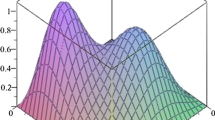Abstract
We consider the computation of stable approximations to the exact solution \({x^\dagger}\) of nonlinear ill-posed inverse problems F(x) = y with nonlinear operators F : X → Y between two Hilbert spaces X and Y by the Newton type methods
in the case that only available data is a noise \({y^\delta}\) of y satisfying \({\|y^\delta - y\| \le \delta}\) with a given small noise level \({\delta > 0}\) . We terminate the iteration by the discrepancy principle in which the stopping index \({k_\delta}\) is determined as the first integer such that
with a given number τ > 1. Under certain conditions on {α k }, {g α } and F, we prove that \({x_{k_\delta}^{\delta}}\) converges to \({x^\dagger}\) as \({\delta \rightarrow 0}\) and establish various order optimal convergence rate results. It is remarkable that we even can show the order optimality under merely the Lipschitz condition on the Fréchet derivative F′ of F if \({x_{0} - x^\dagger}\) is smooth enough.
Similar content being viewed by others
References
Bakushinskii A.B. (1992). The problems of the convergence of the iteratively regularized Gauss–Newton method. Comput. Math. Math. Phys. 32: 1353–1359
Bauer F. and Hohage T. (2005). A Lepskij-type stopping rule for regularized Newton methods. Inverse Probl. 21: 1975–1991
Blaschke B., Neubauer A. and Scherzer O. (1997). On convergence rates for the iteratively regularized Gauss–Newton method. IMA J. Numer. Anal. 17: 421–436
Deuflhard P., Engl H.W. and Scherzer O. (1998). A convergence analysis of iterative methods for the solution of nonlinear ill-posed problems under affinely invariant conditions. Inverse Probl. 14(5): 1081–1106
Hanke M. (1997). A regularizing Levenberg–Marquardt scheme with applications to inverse groundwater filtration problems. Inverse Probl. 13: 79–95
Hanke M. (1997). Regularizing properties of a truncated Newton–CG algorithm for nonlinear inverse problems. Numer. Funct. Anal. Optim. 18: 971–993
Hanke M., Neubauer A. and Scherzer O. (1995). A convergence analysis of Landweber iteration of nonlinear ill-posed problems. Numer. Math. 72: 21–37
Hohage T. (1997). Logarithmic convergence rates of the iteratively regularized Gauss–Newton method for an inverse potential and an inverse scattering problem. Inverse Probl. 13(5): 1279–1299
Jin Q.N. (2000). On the iteratively regularized Gauss–Newton method for solving nonlinear ill-posed problems. Math. Comp. 69(232): 1603–1623
Jin, Q.N.: A convergence analysis of the iteratively regularized Gauss–Newton method under the Lipschitz condition, Inverse Probl. 24(4), article 045002 (2008)
Jin Q.N. and Hou Z.Y. (1999). On an a posteriori parameter choice strategy for Tikhonov regularization of nonlinear ill-posed problems. Numer. Math. 83(1): 139–159
Kaltenbacher B. (1997). Some Newton-type methods for the regularization of nonlinear illposed problems. Inverse Probl. 13: 729–753
Kaltenbacher B. (1998). A posteriori choice strategies for some Newton type methods for the regularization of nonlinear ill-posed problems. Numer. Math. 79: 501–528
Kaltenbacher, B., Neubauer, A., Scherzer, O.: Iterative Regularization Methods for Nonlinear Ill-Posed Problems, de Gruyter, Berlin (2008)
Rieder A. (1999). On the regularization of nonlinear ill-posed problems via inexact Newton iterations. Inverse Probl. 15: 309–327
Rieder A. (2001). On convergence rates of inexact Newton regularizations. Numer. Math. 88: 347–365
Scherzer O., Engl H.W. and Kunisch K. (1993). Optimal a posteriori parameter choice for Tikhonov regularization for solving nonlinear ill-posed problems. SIAM J. Numer. Anal. 30: 1796–1838
Tautenhahn U. (1997). On a general regularization scheme for nonlinear ill-posed problems. Inverse Probl. 13(5): 1427–1437
Tautenhahn U. and Jin Q.N. (2003). Tikhonov regularization and a posteriori rules for solving nonlinear ill posed problems. Inverse Probl. 19(1): 1–21
Vainikko, G.M., Veretennikov, A.Y.: Iteration Procedures in Ill-Posed Problems, Moscow, Nauka, 1986 (in Russian)
Author information
Authors and Affiliations
Corresponding author
Rights and permissions
About this article
Cite this article
Jin, Q., Tautenhahn, U. On the discrepancy principle for some Newton type methods for solving nonlinear inverse problems. Numer. Math. 111, 509–558 (2009). https://doi.org/10.1007/s00211-008-0198-y
Received:
Revised:
Published:
Issue Date:
DOI: https://doi.org/10.1007/s00211-008-0198-y



